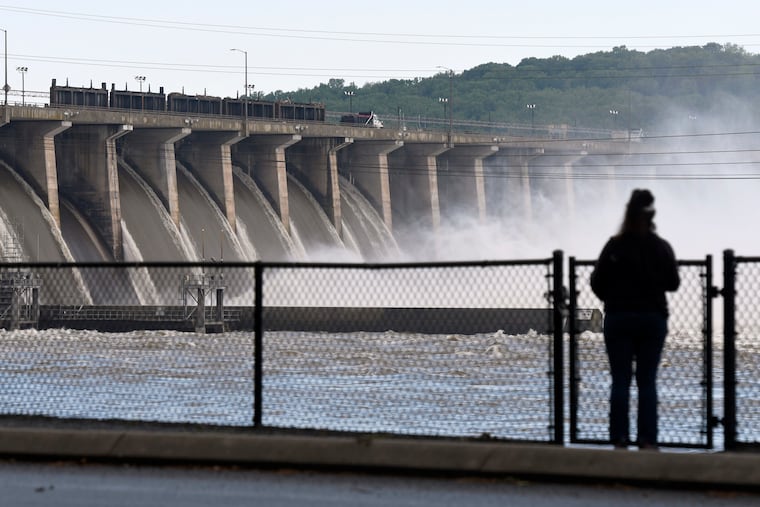Pa. efforts to curb Chesapeake pollution have stalled, leaving the bay at risk | Opinion
The Susquehanna River, flowing mostly through Pennsylvania, is responsible for nearly 50 percent of the flow into the Chesapeake Bay.

This summer, the Chesapeake Bay has one of its largest dead zones in the last 30 years. And Pennsylvania pollution is a significant contributor to that problem.
One river, the Susquehanna, flowing mostly through Pennsylvania, is responsible for nearly 50 percent of the flow into the Chesapeake Bay. Frustratingly, pollution that has been entering the Susquehanna continues to flow downstream into the bay at levels that are putting the entire bay recovery at risk. The affected states, the District of Columbia, and the U.S. Environmental Protection Agency (EPA) can no longer stand by and let that happen.
The Chesapeake Bay’s restoration is at a pivotal moment. Every state needs to do its fair share, and the federal government needs to do its job to hold all accountable, to reduce the pollution that has been flowing down state waterways and choking the bay.
Clean water for 18 million people and an estimated $130 billion in annual natural resources benefits hang in the balance. The Chesapeake Bay is the nation’s largest estuary, a vast system of freshwater streams, tidal rivers, and coastal wetlands across a 64,000-square-mile watershed. It’s not just worth protecting, it must be protected.
Real progress has already been achieved. Farmers, many state and local governments, and businesses have stepped up. As a result, the partnership achieved an estimated 40% of its nitrogen reduction goal and 87% of its phosphorus reduction goal between 2009 and 2017.
But efforts in Pennsylvania have stalled, and the state is falling behind in its commitment to the bay and to the other jurisdictions that are far in front. Simply put, the commonwealth’s current plan to cut pollution falls far short of its requirements under the agreed upon Chesapeake Clean Water Blueprint allocations. Even worse, Pennsylvania officials themselves say their plan is underfunded by over $300 million annually.
Without success in Pennsylvania, the entire restoration partnership is at risk of failing, and the bay will not recover.
We served as EPA administrators under two presidents, one a Republican and one a Democrat. What began in 1983 as a largely voluntary effort to reduce pollution in the Chesapeake became a federal mandate to enforce the Clean Water Act. In 2010, under President Barack Obama, EPA established science-based pollution limits for the bay. That action had teeth — it gave birth to the Chesapeake Clean Water Blueprint, which allocated pollution reduction targets to each of the six bay states and the District of Columbia, and set a deadline of 2025 to ensure all measures are in place to reach those targets. EPA can impose financial and regulatory consequences on any jurisdiction that fails to meet its commitments.
Against the backdrop of a federal administration hell-bent on dismantling the Clean Water Act — the foundational law that protects our nation’s waterways — the Chesapeake Bay Executive Council meets on Thursday to chart the final phase of the most ambitious environmental restoration effort ever initiated under the law’s purview. The council, which includes the governors of each bay state, the mayor of the District of Columbia, the chair of the Chesapeake Bay Commission, and the EPA administrator, must collectively work together to take a firm stand.
Reducing pollution in Pennsylvania alone won’t in and of itself save the bay. But it will help clean 19,000 miles of polluted streams, so the folks in Pennsylvania who deserve a clean river to fish and swim in get that chance, and the folks downstream get to enjoy the pollution reduction benefits as well.
» READ MORE: Philadelphia’s Wissahickon is slammed with millions of visitors, increasing trash, noise, risks
A proposed resolution drafted by the Chesapeake Bay Foundation is a good start. If passed, it will commit the council to helping Pennsylvania raise the necessary funds to get its part of the restoration job done. If Pennsylvania does not get its job done, then EPA will be asked to use its Clean Water Act authority to hold the commonwealth accountable to its targets. The resolution is not a giveaway; it is an offer to help with insurance backing it up.
The Chesapeake Bay is a national treasure. Saving it is a national imperative that will fulfill a commitment our country made a half-century ago to ensure all waterways are fishable, swimmable, and clean. It is time for leadership.
Gina McCarthy served as EPA administrator for President Barack Obama from 2013 to 2017. William Reilly served as EPA administrator for President George H.W. Bush from 1989 to 1993.